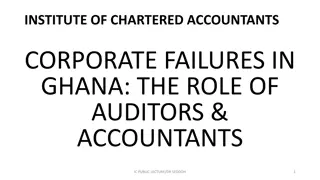Overview of Corporate Governance Practices
This content provides insights into corporate governance, focusing on the definitions, principles, disclosure, transparency, and responsibilities of the board of directors. It delves into the system of checks and balances that ensure companies act accountably and responsibly towards stakeholders. Key topics include the Cadbury Report, OECD Principles, and the role of stakeholders in governance.
Download Presentation

Please find below an Image/Link to download the presentation.
The content on the website is provided AS IS for your information and personal use only. It may not be sold, licensed, or shared on other websites without obtaining consent from the author.If you encounter any issues during the download, it is possible that the publisher has removed the file from their server.
You are allowed to download the files provided on this website for personal or commercial use, subject to the condition that they are used lawfully. All files are the property of their respective owners.
The content on the website is provided AS IS for your information and personal use only. It may not be sold, licensed, or shared on other websites without obtaining consent from the author.
E N D
Presentation Transcript
International Corporate Reporting Chapter 11 Corporate governance
Definitions Corporate governance is the system by which companies are directed and controlled. (Cadbury Report, UK, focus on process) The collections of control mechanisms that an organisation adopts to prevent or dissuade potentially self-interested managers from engaging in activities detrimental to the welfare of shareholders and stakeholders. (this wording includes potential motives)
Definitions (contd) Corporate governance is the system of checks and balances, both internal and external to companies, which ensures that companies discharge their accountability to all their stakeholders and act in a socially responsible way in all areas of their business activities. (this wording focuses on wider accountability beyond immediate principal-agent duty of directors)
OECD Principles Principles of corporate governance: Ensuring the basis for an effective corporate governance framework. The rights and equitable treatment of shareholders and key ownership functions. Institutional investors, stock markets, and other intermediaries. The role of stakeholders in corporate governance. Disclosure and transparency. The responsibilities of the board.
Disclosure and transparency 1 the financial and operating results of the company; 2 company objectives and non-financial information; 3 major share ownership, including beneficial owners, and voting rights; 4 remuneration of members of the board and key executives; 5.information about board members including their qualifications, selection process, other directorships and whether they are regarded as independent by the board; 6 related party transactions; 7 foreseeable risk factors; 8 issues regarding employees and other stakeholders; and 9 governance structures and policies, including the content of any corporate governance code or policy and the process by which it is implemented.
Responsibilities of the board of directors act in the best interests of the company and the shareholders; treat all shareholders fairly; apply high ethical standards; fulfil certain key functions (listed in the report) including ensuring the integrity of the accounting and financial reporting system, making arrangements for independent audit, and ensuring that appropriate systems of control are in place for risk management, financial and operational control and compliance with law and standards; align key executive and board remuneration with the longer term interests of the company and its shareholders (covering also selection, compensation and monitoring of key executives); exercise objective independent judgement; and oversee the process of disclosure and communications.
Corporate governance models Shareholder-centric Primary responsibility of a company is maximisation of shareholder wealth. Corporate governance codes or laws are focused on meeting the needs of shareholders. Stakeholder-centric Shareholder is stakeholder alongside employees, suppliers, customers and local communities. Corporate governance laws give protection, such as allocating places on a board of governance.
Corporate governance codes May be: Established under the authority of national governments. Imposed by national securities regulators on listed companies. Voluntary codes proposed by institutions or bodies with an interest in improving the way in which companies are managed.
Features of national codes General features are: stakeholder and shareholder interests; supervisory and managerial bodies; code enforcement and compliance; and disclosure and transparency. Specific details may be affected by: Ownership concentration Business practice Legal system
Emerging economies May feel pressured to accept an Anglo-American model of a Code. Pressure may come from development agencies requiring assurance for investment. Government or regulator may give precedence to the desire to improve international legitimacy, rather than suit nature of local business. Challenge of recognising traditional cultures in family-based businesses. Problems of weak enforcement
Stewardship codes Leads on from action by shareholders to enforce good standards of corporate governance, acting individually or in pressure groups. ICGN Global Stewardship Principles set out best practices in relation to investor stewardship obligations, policies and processes. Global Stewardship Codes Network is an informal network that enables members to share information and views on the development and implementation of codes.
Case study- Sweden Swedish Corporate Governance Code, revised in 2015, is a non-mandatory code prepared by the Swedish Corporate Governance Board, working within the Securities Market. It forms part of the self-regulation of the corporate sector. Comply or explain about governance arrangements, but fully explain in information disclosure.
Sweden- Ericsson, disclosures Regulation and compliance Governance structure Shareholders and General Meetings of shareholders Nomination Committee Board of Directors Committees of the Board of Directors Remuneration to Board members Members of the Board of Directors Management and Members of the Executive Team Auditor Internal control over financial reporting Auditor s report on the Corporate Governance Report
Case study- Malaysia Malaysian Code on Corporate Governance, 2017, states a new approach of Comprehend, Apply and Report . Three principles are identified as A: Board leadership and effectiveness. B: Effective audit and risk management. C: Integrity in corporate reporting and meaningful relationship with stakeholders.
Malaysia Axiata, disclosures Group Corporate Structure Profile of Directors Board Remuneration Directors' Training List Profile of Group Senior Leadership Team Profile of Operating Companies Management Team Significant Milestones Awards Statement on Risk Management and Internal Control Board Audit Committee Report Commitment to Customer Privacy and Data Protection Additional Compliance Information
Enforcement comply or explain Companies should make a statement about their compliance with the Code in the report and accounts and give reasons for any areas of non- compliance. This recommendation is intended to minimise the reporting burden while making clear any departure from the Code. If enforced by a stock exchange, effectiveness of enforcement depends on the rigour of the exchange s monitoring and enforcement departments.
Rules-based enforcement OECD points to Germany and South Korea, as examples of jurisdictions that apply control via statute law, in that the ministry in charge of the companies law is also substantially responsible for the enforcement of corporate governance issues. However in Germany the Commission (Regierungskommission Deutscher Corporate Governance Kodex) refers to comply or explain within a statutory framework.
Rules-based enforcement (contd) India, the ministry in charge and SEBI, the regulator of the securities market, both are responsible for enforcement of corporate governance issues. US, state law is the primary source of corporate governance law, but the federal securities regulator (SEC) and exchanges regulate certain governance matters.
Corporate governance ratings Worldwide Governance Indicators (WGI) provided by the World Bank. Commercial databases provide ratings for corporate governance that may be used by investors in evaluating companies. Institutional Shareholder Services (ISS) (Wharton). UK- Institute of Directors Good Governance Index (GGI)
ROSC reports, World Bank (Reports on the Observance of Standards and Codes) A typical ROSC report on corporate governance will assess the country s corporate governance policy framework; highlight recent improvements in corporate governance regulation; make policy recommendations; and provide investors with a benchmark against which to measure corporate governance in the country.
Research examples Suggestions for comparative studies. Journal editors analysis of themes from current work. CG in emerging economies. Review paper setting out potential research areas. State versus private ownership. Database across 66 countries, matched pairs evaluation of performance. CEO duality. Study across 14 countries, separate or combined CEO and chair. Board gender diversity. Performance linked to board characteristics.























